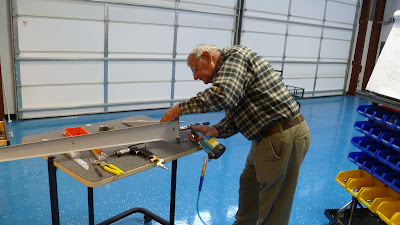Here are some more pictures to finish off the rudder build. These first pictures are out of order as they were taken during the rudder frame assembly, but I didn't feel like I had enough to make an worthwhile blog post. So I'll throw them in here to complete the rudder section of this blog.
While riveting a backing plate to the spar I created this common imperfection known to aircraft builders as a 'smiley.' Although in this orientation it's more of a 'frownie', like my face when I first spotted it.
These are definite no-nos, so the little booger must come out. First thing is to drill through the head just down to the level of the shank. One must be careful at this point to not drill through as this would most likely enlarge the hole in the parts being mated.
With the head drilled, a pin punch the same size as the drill is placed into the hole and gently rocked back and forth until the head breaks off. Then the punch is used to hammer the shank through the hole. If you've done it correctly, a new rivet can be placed into the same hole and you get another whack at it.
My friend Chuck came over to help me while I was putting the rudder frame together.
 |
| Last rivets in the rudder frame. |
Then it's time to rivet the skins to the frame. Not a lot of pictures here. But, this one shows the intersection the left rudder skin and the counter balance skin. The numbers are the rivet sizes which vary depending on whether the rivet is going though just the skins, or through the skins and spar or top rib.
At this point, I think I'm about ready to rivet the trailing edge. And then I see two parts sitting on my work bench. Oh #@$%^!, I've left out the R918s. These were the pieces that Carolina had prepared in a previous post. I would be in the doghouse if I left these off. Also, I wouldn't be able to attach my lower rudder tip. Which would, no doubt, be an unwanted conversation item while standing around at the fuel pump.
The final step to complete the rudder is rolling the leading edge. Pictured below is the J-bolt method in practice. The picture is too close to understand what is going on here, but rest assured that everything is in order. The left and right skins extend beyond the spar and are rolled into a semicircle to meet in the center.
To roll the skins they are first attached to a length of 3/4" iron pipe, although a pipe made of just about any material except foam rubber would probably work just fine. What is seen in the picture is the duct tape attaching skin to pipe with the skin not quite visible under the pipe. The J bolts are in this case a U bolts with one leg cut off (or 11 letters). When the pipe is turned the skin is pulled along and formed into a pleasing aerodynamic shape.
Well, that is the theory. In practice it also took a considerable amount hand forming, bending, squeezing, pressure, and some profanity to accomplish.
Finally the completed rudder. All that is left at this point is to install the rod end bearings. To make that job easier, I constructed an installation tool as detailed on Sam Bucanan's web site. Thanks Sam.

Next post: The elevator begins.